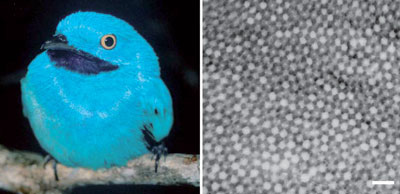| Posted: April 29, 2009 |
Attracting a mate, nano-style |
|
(Nanowerk News) Some of the most vivid colours in the animal kingdom are produced by nanostructures scattering light, rather than pigments, say US researchers (Self-assembly of amorphous biophotonic nanostructures by phase separation – free access article).
|
|
Eric Dufresne and Richard Prum from Yale University and colleagues looked at how bird feather barbs, the structures that branch from the main feather shaft, gave the birds their colours. They found that the barbs contain nanostructures that scatter different light wavelengths, producing the colours.
|
 |
| The Plum-throated Cotinga's turquoise colour could occur because of nanostructures in its feathers.
|
|
The nanostructures, which consist of a protein called beta-keratin and air, are made when the protein in the feathers' cells starts to polymerise. The polymer separates from a part of the cell called the cytoplasm. This is phase separation (unmixing), which stops when the protein's fibres become entangled.
|
|
Many bird species may have evolved to control these processes, suggest Dufresne and Prum. The colours depend on the way the nanostructures are arranged. For example, with the Eastern Bluebird (Sialia sialis), which has a blue-black plumage, the nanostructures are made up of beta-keratin bars and air channels in twisted forms. The turquoise plumage of the Plum-throated Cotinga (Cotinga maynana) could be caused by its spherical nanostructures.
|
|
Colour plays an important role in social and sexual communication in the animal kingdom. Any variation in nanostructure dimension could result in ineffective social or sexual communication signals.
|
|
|
|
As well as helping us to understand the mechanisms underlying the evolution of beauty in nature, Dufresne adds that his research has the 'potential for finding a new class of photonic materials (light-emitting materials), based on disordered, instead of periodic structures.'
|
|
Dufresne and Prum say they hope to explore the phase separation of feather protein in vitro and conduct analyses of other coloured biomaterials. This future work would indicate whether similar self-assembly mechanisms are widespread, they say.
|

